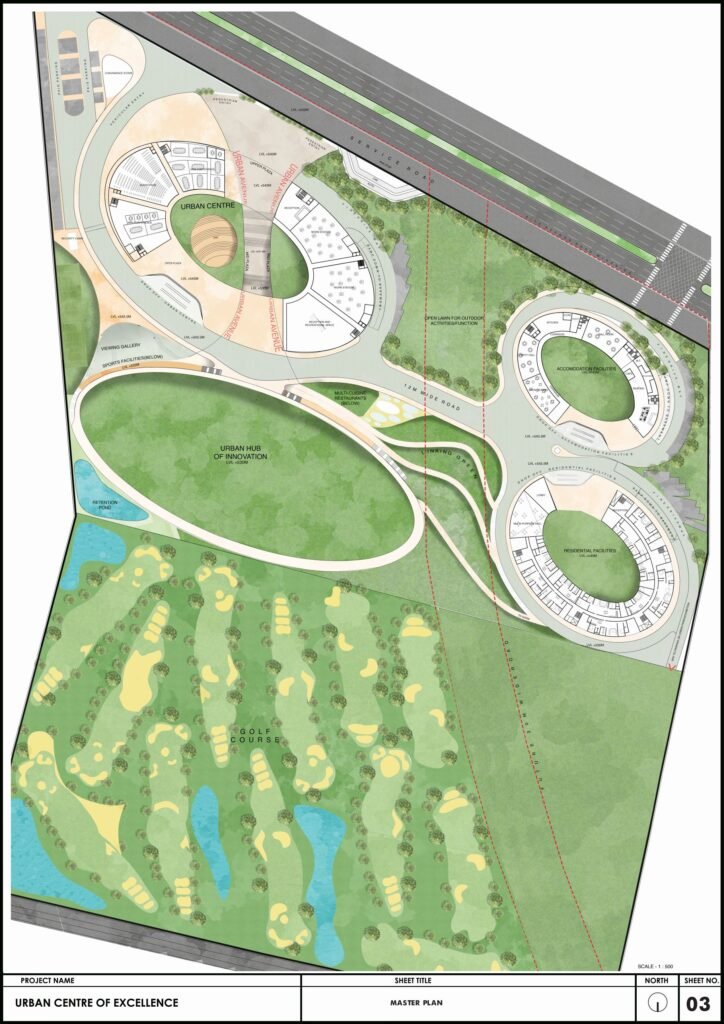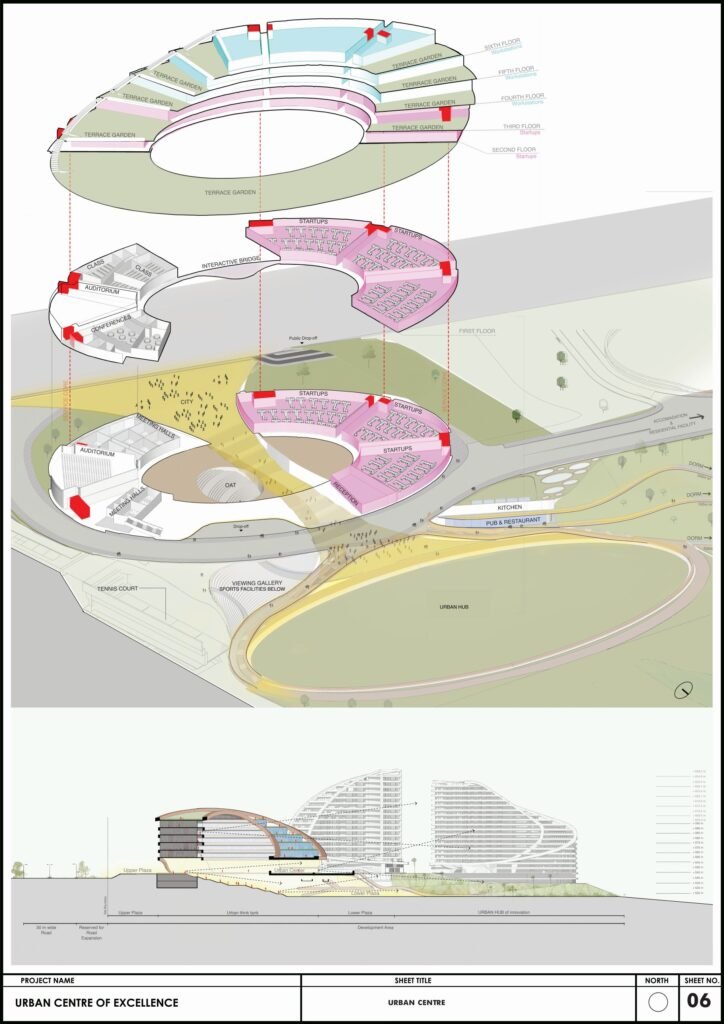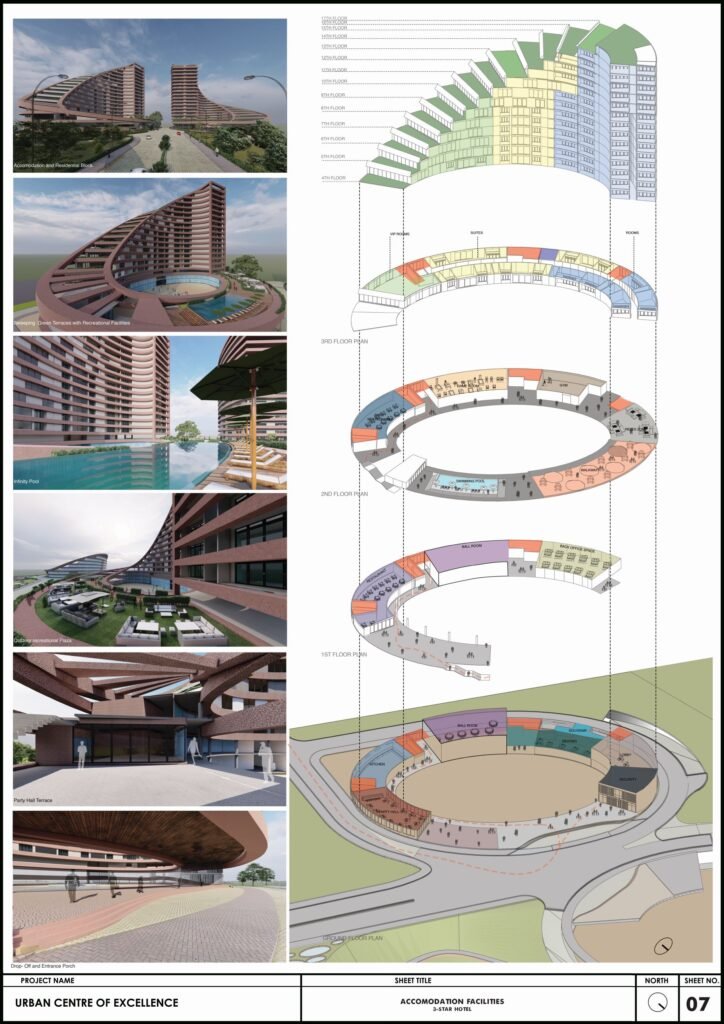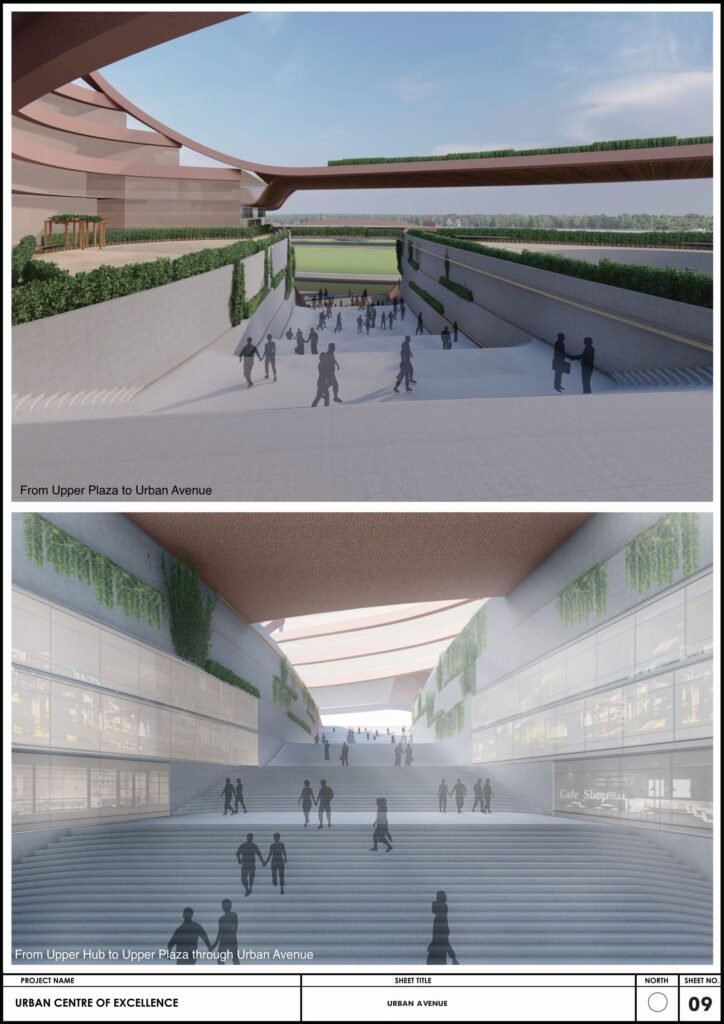Urban Centre of Excellence, Hyderabad
Project Name : Urban Centre of Excellence
City : Hyderabad
Project Status : Design-Competition
Year of Completion : NA
Project Category : Commercial-Mixed Use Architecture
Total Built-up Area : 1,02,050 Sqm
No. of Floors : B1+B2+LG+UG+20 floors
Design Team : Ramya, Sathwik, Rachana and CK
Landscape Architects : 4site architects
Keeping in mind the institutional nature of the site surrounding and the project brief, the concept – “pool of ideas and loop of feedback”, was evolved. The design revolves around pooling in research minds and creating a loop of feedback for them to benefit from. This idea was further explored by understanding the difference between a ‘study’ and ‘research’. Study happens to be a linear understanding of given information. Whereas research involves a cycle of brainstorming, assessments, deliberations and evaluations after which feedback is sought on the produced work and re-ideation begins before the next loop of study.
The pooling of ideas occurs in the Urban center which facilitates thinking, processing information and prototyping initial outputs. These outputs of experimentation are showcased in the urban hub which is open to feedback from the general public and bureaucracy. Then a connection is formed between the two, looping up the produce and the feedback in the form of an enriched urban think tank.
This connect is the Urban Avenue that opens up the proposed transport hub along the outer edge of the site to the innermost working and experimentation of the urban centre, creating an effective space for our researchers to understand the needs of the city and develop its future plan accordingly.
Renders
STRATEGY:
Once this idea was envisioned, we incorporated it into all aspects of the centre, making social
interaction the soul of the project. The first design thought was to generate a circulation
pattern that would automatically ease the zoning of the respective blocks while aiding the
flow of interaction. It allows for unhindered movement of life across the site considering the
future HMDA proposals for roads
Design aspects such as research facilities, recreation, accommodation and arenas utilise
sustainable design aspects such as green roofs, passive cooling and segregated waste
management to add to the workability of the project. The zoning of the accommodation units
and recreational facilities along with the transport hub keeps in mind the ever-growing city
future and accommodates possible small-scale businesses and resulting influx of users.
This initial design thought laid foundation to unique use of interactive design strategies
such stepped terraces that enhance communication and instant feedback. The vastu
compliant design divides the accommodation units towards the existing highway giving them
opportune views while making these south west units the highest, north east exhibition space
the lowest, and ensuring natural shade throughout the year.
PROJECT APPROACH
STEP 1: Resolution of Circulation– The first step was to resolve the circulation in
such a way that it forms an uninterrupted loop facilitating research and feedback in the
present, while accommodating the future proposed road. After multiple iterations, the final
design contains one loop binds together the urban centre, urban hub, sports and the golf
course while the other connects the accommodation and residences in close proximity. The
smallest quadrant at the rear end can be used as variable land for farming and agriculture.
Both the loops will remain undisturbed even after the future road implementation.
STEP 2: Zoning– The next step was to analyse the different user groups and plan forms
that eased respective activities. At the master planning stage, this analysis led to effective
zoning of public, semi public and private zones. The Urban Avenue which is the main link
between the city and the site design divides the space into 3 zones. The main strip is entirely
open to public and is divided across levels to ensure playfulness and excitement to attract the
general public. It simultaneously divides the space into selective semi public and private
spaces for the researchers.
STEP 3: Relationship between people and built form– The next challenge was
to ensure interaction between the different built forms, and between forms and people. All the
forms evolved in such a way that they increase visibility between the urban centre and public
arenas. The visibility is heightened by the play of levels along public plazas, avenues and
stepped terraces, hence creating excitement among visitors to explore the site more. The
form also ensures sufficient shade along public plazas throughout the year making it
comfortable for users to passively use public zones of the site.
STEP 4: Finishing and elevational integrity– The final challenge was the ensure
that materiality ensures workability of design. The entire structure uses concrete since it
facilitates experimental forms such as the ones in the design. The fins use terracotta
pigmented concrete in order to visually match the boulders along the site.
Drawings
![Urban Centre of Excellence, Hyderabad - old 12 [Urban Centre of Excellence]-[Hyderabad]-4site architects, architects in Bangalore](https://4sitearchitects.com/wp-content/uploads/2023/06/001-1-724x1024.jpg)
![Urban Centre of Excellence, Hyderabad - old 13 [Urban Centre of Excellence]-[Hyderabad]-4site architects, architects in Bangalore](https://4sitearchitects.com/wp-content/uploads/2023/06/002-1-724x1024.jpg)


















